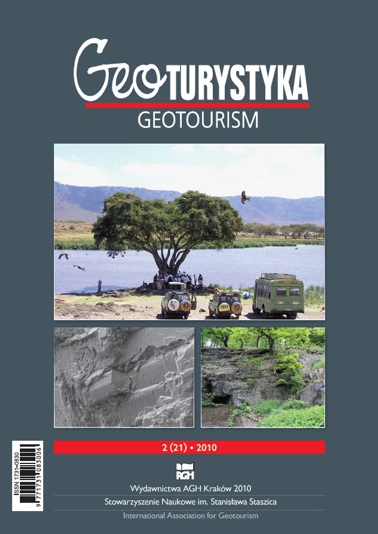Unused potential of abandoned quarries on the example of Wieżyca and Chwałków (Lower Silesia)
DOI:
https://doi.org/10.7494/geotour.2010.21.27Słowa kluczowe:
mining operations, quarry, abandoned quarries, geotourism, SobótkaAbstrakt
The proper development of abandoned mine workings is the aesthetic, environmental and economic problem. Abandoned quarries are subjected to natural remediation by reconstruction of groundwater table and expansion of plants. Troubles arise when abandoned quarries become illegal landfills and when steep, commonly vertical, unprotected walls, and/or deep reservoirs may become lethal traps. However, the same, hazardous elements: walls and reservoirs can be attractions for both the local residents and the tourists. Values of abandoned quarries were appreciated and developed in the past with positive effects. The authors present examples of two quarries from the vicinity of Ślęża in Lower Silesia, which should encourage us to consider such sites as elements of local economy and to perceive their undeveloped potential.Pobrania
Bibliografia
Dziedzic, K., Kozłowski, S., Majerowicz, A., Sawicki, L. (red.), 1979. Surowce mineralne Dolnego Śląska. Zakład Narodowy im. Ossolińskich, Wydawnictwo Polskiej Akademii Nauk, Wrocław–Warszawa–Kraków–Gdańsk, s. 510.
Kozłowski, S., 1986. Surowce skalne Polski. Wydawnictwo Geologiczne, Warszawa, s. 538.
Lorenc, M.W., 1984. Enklawy homeogeniczne (autolity) jako wskaźnik magmowego pochodzenia granitoidów strzelińskich. Geologia Sudetica, 19, 1: 75–100.
Lorenc, M.W., 1994. Rola magm zasadowych w ewolucji intruzji granitoidowych (studium porównawcze wybranych masywów hercyńskich). Geologia Sudetica, 28, 1: 3–121.
Lorenc, M.W., 2005. Badania petrograficzne w pracach konserwatorskich. Materiały Konferencji Naukowej Postęp i nowoczesność w konserwacji zabytków, 2–3.06.2005 Lublin: 40–44.
Lorenc, M.W., 2010. Historic mines applied for tourism – selected examples from Europe. International Conference Problems of protecting the heritage of material culture of historical mines in the European Union countries, Wieliczka 4–6.11.2010, Proceedings: 1–2.
Lorenc, M.W., Cocks, A., 2008. Inscribing a landscape: the Cornish Mining World Heritage Site. Geoturystyka, 1 (12): 27–40.
Lorenc, M.W., Janusz, M., 2010. Mining heritage sites as cultural heritage sites. World Universities Congress. Çanakkale (Turkey), 20–24.10.2010. Proceedings II: 1581–1593.
Lorenc, M.W., Mazurek, S., 2010. Wybrane, nowe propozycje geoturystyczne z Dolnego Śląska. Geoturystyka (w druku).
Majerowicz, A., 1969. Masyw granitowy Strzegom-Sobótka, W: Grocholski, W. (ed.), Przewodnik geologiczny po Sudetach. Wydawnictwa Geologiczne, Warszawa: 493–506.
Majerowicz, A., 1972. Masyw granitowy Strzegom-Sobótka. Studium petrologiczne. Geologia Sudetica, 6: 7–96.
Pérez Sánchez, A.A., Lorenc, M.W., 2008. The cultural landscape of the Linares-La Carolina mining district. Geoturystyka, 3(14): 13–24.
Pietrzyk-Sokulska, E., 2003. Kamieniołomy surowców skalnych w polskim krajobrazie. Międzynarodowa Konferencja Naukowa Kształtowanie krajobrazu terenów poeksploatacyjnych w górnictwie, 10–12 grudnia 2003 Kraków: 43–52.
Malewski, J. (red.), 1999. Zagospodarowanie wyrobisk. Technologiczne, przyrodnicze i gospodarcze uwarunkowania zagospodarowania wyrobisk poeksploatacyjnych surowców skalnych Dolnego Śląska. Oficyna Wydawnicza Politechniki Wrocławskiej, Wrocław: 103–108.
Taras, E., 2008. Region ślężański skarbnicą skał i minerałów, ewenement geologiczny w przyrodzie. Wydawnictwo AVR ANTEX Sobótka, s. 424.



